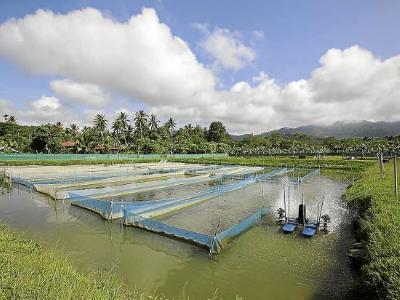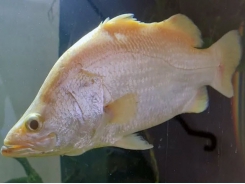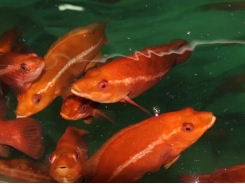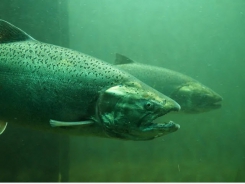Nitrite problem in Freshwater Fish Aquaculture

Nitrite problem in Freshwater Fish Aquaculture and its control strategies:
Nitrite enters a fish culture system after feed is digested by fish and the excess nitrogen is converted into ammonia, which is then excreted as waste into the water. Total ammonia nitrogen (TAN; NH3 and NH4+) is then converted to nitrite (NO2) which, under normal conditions, is quickly converted to non-toxic nitrate (NO3) by naturally occurring bacteria. Uneaten (wasted) feed and other organic material also break down into ammonia, nitrite and nitrate in a similar manner. Brown Blood Disease occurs in fish when water contains high nitrite concentrations. Nitrite enters the bloodstream through the gills and turns the blood to a chocolate-brown color. Hemoglobin, which transports oxygen in the blood, combines with nitrite to form Methemoglobin, which is incapable of oxygen transport. Brown blood cannot carry sufficient amounts of oxygen and affected fish can suffocate despite adequate oxygen concentration in the water. This accounts for the gasping behavior often observed in fish with brown blood disease, even when oxygen levels are relatively high.
Nitrite problems are typically more likely in closed culture systems due to insufficient, inefficient management and malfunctioning filtration systems. High nitrite concentrations in ponds occur more frequently when temperatures are fluctuating, continuous cloudy or rainy weather conditions resulting in the breakdown of the nitrogen cycle due to decreased plankton and/or bacterial activity. A reduction in plankton activity in ponds (because of lower temperatures, nutrient depletion, cloudy or rainy weather, herbicide/insecticide treatments etc.) can result in less ammonia assimilated by the algae, thus increasing the load on the nitrifying bacteria. If nitrite levels exceed that which resident bacteria can rapidly convert to nitrate, a buildup of nitrite occurs, and brown blood disease is a risk. Although nitrite is seldom a problem in systems with high water exchange rates or good filtration, systems should be monitored year-round and managed when necessary to prevent severe economic loss from brown blood in any fish culture facility.
Susceptibility of fish species to nitrite toxicity
Warmwater fishes like Corps, Catfishes, Tilapia are fairly sensitive to nitrite, and trout and other coolwater fish are sensitive to extremely small amounts of nitrite. Since this is a nitrogen-related problem, the most obvious preventive measure is to reduce or minimize the amount of nitrogen incorporated into the system by reducing feeding rates. However, in modern intensive pond or closed system fish culture with high densities and rapid growout, longterm feed reduction is not considered by most farmers as a viable option. Luckily, although we often cannot prevent the occurrence of high nitrite, its effects can be minimized or neutralized safely and economically through bioremediation (BioRemid-Aqua, TekTron-BT).
Whereas in severe cases Sodium Chloride (common salt, NaCl) is used to “treat” brown blood disease. Calcium chloride can also be used but is typically more expensive. The chloride portion of salt competes with nitrite for absorption through the gills.
Maintaining at least a 10 to 1 ratio of chloride to nitrite in a pond effectively prevents nitrite from entering fish. Where fish have bacterial and/or parasite diseases, their sensitivity to nitrite may be greater, and a higher chloride-tonitrite ratio may be needed to afford added protection from nitrite invasion into the bloodstream. As a general rule, catfish producers strive to maintain at least 100 ppm chloride in pond waters as “insurance” against high spikes of nitrite concentration. Culturists of other species may want to assume that nitrite is a potential problem and use salt as an insurance buffer as well.
How to calculate the amount of salt needed to treat
Before treatment rates can be calculated, chloride and nitrite concentrations in the water, as well as pond volume, must be determined. Commercially available water quality test kits can be used. The amount of salt needed for the pond can be calculated using the following formulas:
Formula 1
Partsper million (ppm) of chloride to add to the pond = (10 x pond nitrite concentration) - (pond chloride concentration)
The number “10” used in this formula is the minimum desired chloride:nitrite ratio number. It is used here to get a 10 to 1 chloride to nitrite ratio. If a higher ratio is desired, substitute the higher number for the 10.
If the answer is zero or a negative number, chloride concentration is sufficient to prevent brown blood disease.
Use the answer from Formula 1 above in the following formula:
Formula 2
Salt (NaCl) needed to add to the pond = Surface acres x average depth in feet x ppm of chloride to add to the pond x 2.04
You need 2.04 kg of salt to increase the chloride concentration by 1 ppm in an acre-foot of water.
Example
The following readings are obtained from a 20-acre fish pond with an average depth of 4 feet: 4 ppm nitrite and 15 ppm chloride
Use Formula 1:
(10 x 4 ppm nitrite) - 15 ppm chloride in the pond = 40 - 15 = 25 ppm chloride to add to the pond
Now use Formula 2:
20 acres x 4 feet average depth x 25 ppm chloride to add to the pond x 2.04 = 4,080 kg of salt needed to add to the pond. (i.e. half a ton of salt is required per hectare area of a pond)
Application of salt
Distribute the salt evenly and quickly when fish are suffering from brown blood disease. It takes about 24 hours after salt is applied to a pond for the brown blood condition to be alleviated. A good water quality monitoring program can help prevent brown blood disease. Pond water should be checked for nitrite once in a week. Check ponds daily during a known high nitrite incident, even if adequate chlorides are in the ponds. Also check chloride after periods of heavy rain or cloudy weather or during water exchange or filling; all these events can dilute chloride concentrations and reduce the chloride:nitrite ratio.
Nitrite can increase very suddenly, so it is advisable to monitor at all times to minimise the incidence of fish mass mortalities. Another way to help manage brown blood disease is by checking total ammonia nitrogen (TAN) concentrations in ponds every week. Every 1 ppm TAN can convert to 3 ppm nitrite in a relatively short period. High TAN levels can alert the farmer to anticipate nitrite problems within a few days and nitrite problems can thus be predicted and then prevented. In many areas, pond with regular use of BioRemid-Aqua can reduce TAN drastically thereby reduce the incidence of brown blood disease in fishes. Water should still be monitored frequently, however, since chloride levels can fluctuate widely and frequently.
In brief:
Nitrite poisoning follows closely on the heels of ammonia as a major killer of aquaculture species. Anytime ammonia levels are elevated in ponds due to improper management, then elevated nitrites will soon follow. To avoid nitrite poisoning, test the soil condition in cases when setting up a new ponds, while when stocking the seed, when the aeration fails due to power or mechanical failure and when treating the stock.
Symptoms:
- Fish gasp for breath at the water surface
- Fish hang near water outlets
- Fish are listless
- Tan or brown gills
- Rapid gill movement
In fishes this is also known as 'brown blood disease' because the blood turns brown from an increase of methemoglobin. However, methemoglobin causes a more serious problem than changing the color of the blood. It renders the blood unable to carry oxygen and the fish can literally suffocate even though there is ample oxygen present in the water.
Different species of fish tolerate differing levels of nitrite. Some fish may simply be listless, while others may die suddenly with no obvious signs of illness. Common symptoms include gasping at the surface of the water, hanging near water outlets, rapid gill movement and a change in gill color from tan to dark brown.
Fish that are exposed to even low levels of nitrite for long periods of time suffer damage to their immune system and are prone to secondary diseases, such as ich, fin rot and bacterial infections. As methemoglobin levels increase damage occurs to the liver, gills and blood cells. If untreated, affected fish eventually die from lack of oxygen and/or secondary diseases.
Treatment:
- Application of BioRemid-Aqua, TekTron-BT, SludgNil.
- Maintenance of D.O .levels by using AOP Plus and OxyZen.
- Water change at high levels of nitrite.
- Application of salt could prevent the bad situation.
- Reduce feeding.
- Increase aeration.
Aeration should be increased to provide ample oxygen saturation in the water. Nitrite is lethal at much lower levels than ammonia. Therefore it is critical to continue daily testing and treatment until the nitrite falls to zero. Feedings should be reduced and no new fish should be added until the ammonia and nitrite levels have fallen to zero.
Prevention:
- Regular use of BioRemid-Aqua, TekTron-BT, SludgNil,
- AOP Plus and OxyZen.
- Test water regularly to catch problems early.
- Change water regularly during higher levels of nitrite
- Stock new ponds slowly while checking the nitrite levels
The key to eliminating fish death is to avoid extreme spikes and prolonged elevation of nitrites. Always test the water for nitrite after an ammonia spike has occurred as there will be a nitrite increase later.
Nitrification is the aerobic conversion of ammonia to nitrite, followed by the aerobic conversion of nitrite to nitrate. Everyone in the aquaculture business
knows how harmful ammonia and nitrite build up can be. Conversion of ammonia to nitrite is accomplished by the action of the bacterium, Nitrosomonas. The conversion of nitrite to nitrate is accomplished by Nitrobacter (BioRemid-Aqua & TekTron-BT). Denitrification occurs in zones where dissolved oxygen is quite low (< 0.5 ppm). Denitrification is the conversion of nitrate to nitrogen gas. It requires bacteria which perform denitrification, and it also requires a source of dissolved organic carbon. When all conditions are present, the nitrate is converted to nitrogen gas and the dissolved organic carbon is converted to CO2, water and new bacterial cells. Of course, nitrogen gas is completely non-toxic.
Sludge accumulation results from excess feed and fecal matter. Sludge build up causes blooms of anaerobic bacteria. These anaerobic bacteria often release hydrogen sulfide, which causes off-flavor problems. Anaerobic bacteria are also likely to be pathogenic to fish. Maximizing sludge build up is critical to fish health and commercial success. The probiotics present in BioRemid-Aqua, CuraMid, SludgNil and TekTron-BT digest sludge and other organic materials thereby improves the overall water quality and minimizes off-flavor and disease.
Related news
Tools

Phối trộn thức ăn chăn nuôi

Pha dung dịch thủy canh

Định mức cho tôm ăn

Phối trộn phân bón NPK

Xác định tỷ lệ tôm sống

Chuyển đổi đơn vị phân bón

Xác định công suất sục khí

Chuyển đổi đơn vị tôm

Tính diện tích nhà kính

Tính thể tích ao




 Hawaii-based Fish 2.0 awardee tripling tilapia growing capacity
Hawaii-based Fish 2.0 awardee tripling tilapia growing capacity